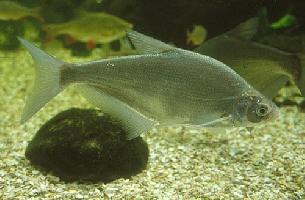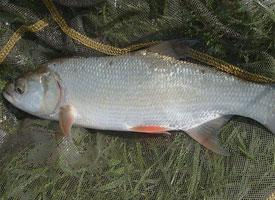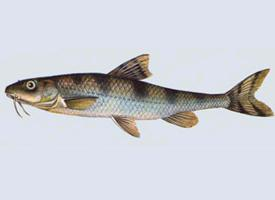
Poids et mesures
| Longueur | 45 cm |
|---|---|
| Poids | 1,8 kg |
Données biologiques
| Durée de vie | 15 r |
|---|
Description de l'animal
The White bream, scientifically known as Blicca bjoerkna, is a fascinating species of freshwater fish that belongs to the Cyprinidae family, which is widely distributed across Europe and parts of Asia. This species is often found in slow-flowing rivers, lakes, and reservoirs, thriving in habitats with abundant vegetation and soft, muddy bottoms. The White bream is a medium-sized fish, with adults typically reaching lengths of 15 to 20 centimeters, although some specimens can grow up to 30 centimeters in favorable conditions.Characterized by its high, laterally compressed body, the White bream exhibits a silvery-grey coloration on its flanks, transitioning to a more vivid white on its belly. This coloration provides an effective camouflage against predators when viewed from below. The fish's back is adorned with a darker shade, ranging from blue-grey to green-grey, which helps it blend into the overlying water when viewed from above. The scales of the White bream are relatively large and possess a distinctive shine, adding to the fish's visual appeal.
One of the defining features of the White bream is its dorsal fin, which is rounded and contains 10-12 branched rays. The anal fin is slightly shorter, and both fins are typically greyish in color, with a transparent quality. The caudal fin is deeply forked, aiding in swift and agile movements through the water. The fish's mouth is small and slightly upturned, an adaptation that facilitates the consumption of zooplankton, insects, and occasionally small plants, which constitute its diet.
The White bream is a gregarious species, often forming large schools that provide safety in numbers from predators such as larger fish and birds. This social behavior also plays a crucial role during the spawning season, which occurs in late spring to early summer. During this period, adults migrate to shallow, vegetated areas of water bodies to lay their eggs. Females can produce up to 100,000 eggs, which adhere to the vegetation and hatch within a few days, depending on the temperature.
Despite its widespread distribution, the White bream is not considered a primary target for commercial fisheries, mainly due to its relatively small size and bony structure. However, it is a popular catch among recreational anglers, who appreciate the challenge it presents and its value as a game fish. Conservation-wise, the White bream is currently not listed as endangered, but like many freshwater species, it faces threats from habitat destruction, pollution, and the introduction of non-native species.
In summary, the White bream (Blicca bjoerkna) is a resilient and adaptable species that plays an important role in freshwater ecosystems. Its distinctive appearance, social behavior, and reproductive strategies make it a subject of interest not only for anglers and conservationists but also for those intrigued by the diversity and complexity of aquatic life.
Animaux similaires
Nouvelles photos d'animaux
Top 10 des animaux
- Dolphin gull (Leucophaeus scoresbii)
- Diana monkey (Cercopithecus diana)
- Moustached guenon (Cercopithecus cephus)
- Galápagos tortoise (Geochelone nigra complex)
- Stone loach (Barbatula barbatula)
- Japanese macaque (Macaca fuscata)
- Russian tortoise (Testudo horsfieldii)
- Greek tortoise (Testudo graeca)
- Common flying dragon (Draco volans)
- Vendace (Coregonus albula)


